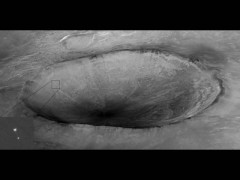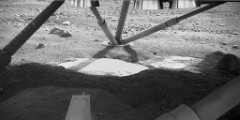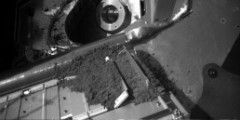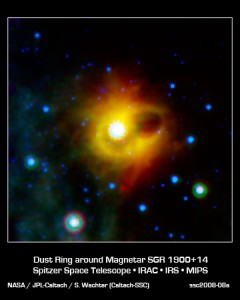|
From Phoenix to Black Holes.... |
 |
|
Written by Nathaniel Whitehead
|
Well surely we have all heard about the exciting and problem free landing of the Mars Phoenix Lander on one news channel or another and rightly so, the mission is gearing up and ready to complete its science goals, with the possibility that it has already completed its chief goal. Also we have news of the discovery of a strange and very large ring around a dead star, the discovery of an important link between galaxy’s spiral arms and the super-massive black holes at their center. Also we have a fantastic talk to share with you that was given at the North Houston Astronomy Club. So let’s get into it shall we…
The Phoenix Mission:
 | | Image above is a 3-D render of the phoenix craft on the northern plains of the Martian surface.
Credit: NASA/JPL-Caltech/University of Arizona |
The Phoenix Lander touched down on Mars after a picture perfect entry and descent on May 25th to begin its primary mission goals after some routine checks and equipment preparation. The Phoenix mission is so named because it is drawn together from some previous and ill fated Mars missions, so the Phoenix is rising from the ashes of the previous similar missions. The main science goals of the Lander are four-fold; 1) to determine if there was ever life on Mars, 2) to characterize the Martian climate, 3) to characterize Martian geology and 4) prepare for future manned missions to the red planet. | |  | | Image above: This is an image of the Phoenix Lander on descent taken by the orbiting craft MRO, in the bottom left is a magnified view of the Lander parachuting down to the Martian surface. Credit: NASA/JPL-Caltech/University of Arizona |
The craft landed in the plains of the north polar region of Mars where orbiting craft have identified water ice set just below a layer of top-soil. After landing and performing initial tasks, like checking solar array deployment and surveying the landing site, Phoenix has unpacked its arm and began its primary mission on the Red Planet. The arm is equipped with a scoop, for digging and sampling at depth in the Martian surface and a camera for recording images of both samples and the trenches from which they came. Once a sample has been dug out of the surface it will be placed in sophisticated equipment onboard the craft to look into the make-up of the Martian dirt and ice. In addition to looking underground the Phoenix is also a weather station, peering 60 miles up and providing the first Martian weather outpost. Shortly into the mission there has been a surprise discovery, the Lander may have landed directly on top of an ice sheet that was exposed by the thrusters. The team says it is possibly ice, but it sure looks like it is, and was discovered when the craft looked underneath itself to check out the state of the Lander’s underside. If this is ice it is an amazing discovery and one that has the astronomy community on the edge of their seats.
 | This is a picture taken by the arm camera underneath the Phoenix Lander, the patch in the center is what could possibly be ice.
Credit: NASA/JPL-Caltech/University of Arizona |
 | | Image above: The sample was placed on the top of the instrument where vibrator plates would usher it into the oven.
Credit: NASA/JPL-Caltech/University of Arizona |
In addition to the possible ice find, the Lander has dug and attempted to deposit the first Martian soil sample into its instruments but there appears to be a problem, the sensor that measures how much of the soil sample got into the instrument didn’t see any of it fall in. The phoenix team thinks it is due to the lumpiness’ of the sample and is already figuring out what went wrong.
Stay tuned for more exciting news from the Phoenix, we will do our best to keep you updated. For more information visit the Phoenix site and our original source;
http://phoenix.lpl.arizona.edu/index.php
Ring around a Dead Star, Pocket Full of Alpha Particles:
Scientists using observations collected by the Spitzer infrared space telescope have discovered a tremendous ring around a dead star called a magnetar. All stars die, some more intensely than others and magnetars are the remains of a star that went supernova leaving a super-dense core that has crazy strong magnetic fields. This magnetar has been dubbed SGR 1900+14 and is seen to have a ghostly ring unlike any other object yet seen. The ring appears to be flat, though could be a sphere, and is very large, seven light years across and three light years wide.
 | | The image above is of the magnetar and the ghostly ring taken by Spitzer.
Image credit: NASA/JPL-Caltech |
The researchers believe that the ring was formed when the magnetar had a giant outburst that cleared out the inside of the ring leaving only the dusty outline of what was once a massive cloud of dust. It is able to be observed because stars nearby are close enough to light it up in infrared wavelengths, and observations show that the remnant is itself related to the other nearby stars. If scientists can understand the mass of the star before it went supernova they might be able to understand what characteristics cause a magnetar to form in the first place and that would be a remarkable breakthrough in astronomical research. Stay tuned for more on the research of this strange and dusty ring.
To read more visit the following link and our original source:
http://www.spitzer.caltech.edu/
Black holes Linked to Galaxies Spiral Arms:Astronomers have known for some time that most, if not every galaxy has in its core a super-massive black hole, sometimes millions if not billions of solar masses and since that discovery they have long wondered what exactly the relationship is between the galaxy’s and their black holes. At the meeting of the American Astronomical Union held in St. Louis a team announced that they had connected the mass of the central black hole in galaxies to the angle of curvature of the spiral arms. | |  | Picture abovet: The spiral galaxy M74, taken by the Hubble space telescope.
Image Credit: NASA and the Hubble Heritage Team (STScI/AURA) -ESA |
Using data collected from 27 different spiral galaxies, our own among them, the team realized that the galaxies with the least massive black holes at their centers had the loosest wrapping of their spiral arms. They are not sure why exactly the relation is the way it is but some believe it has to do with that mysterious dark matter. It has been suggested that the galaxies with the biggest black holes also have the most “concentrated” dark matter, and it is the dark matter that ties the spirals and the black holes together. One of the most advantageous sides of this discovery is that we now have a way to measure the mass of black holes at much, much greater distances, up to 8 billion light years, all that has to be done is the measure the angle of the arms of spiral galaxies and we have a window into its central behemoth.
For more information on this discovery [ click here ]
|

